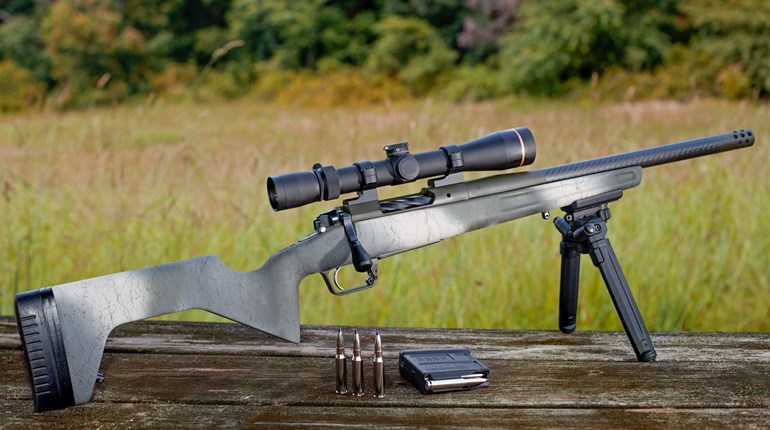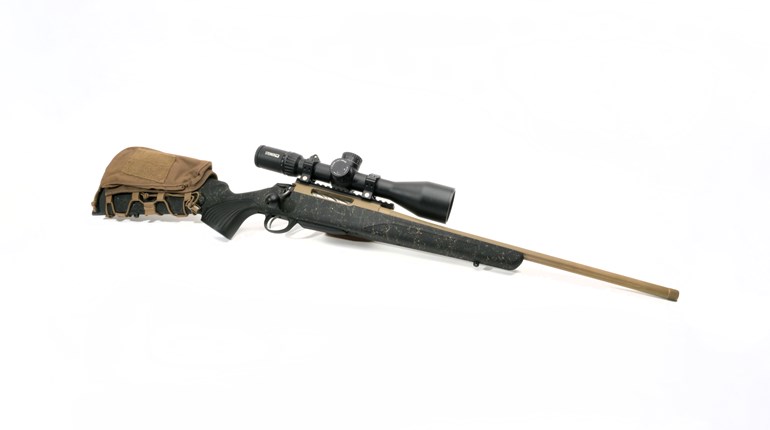
Scout rifles, and rifles that could be considered scout-ish like this Franchi Momentum All-Terrain Strata, still have a place in the modern rifle enthusiast’s armory.
Every so often, a writer’s zeal to report on something or someone in the past tense is a tad bit premature. An obituary for famed author Mark Twain, published 13 years before his demise, led to his famous retort, “The reports of my death are greatly exaggerated.” In 1948, the Chicago Tribune ran an early-edition headline declaring that Thomas Dewey had been elected president, when Harry Truman had actually won the race. And, of course, there were those wide-ranging proclamations that the dissolution of the Soviet Union heralded the death of communism.
Unfortunately, gunscribes are no more immune to poor prognostication skills than anyone else who endeavors to inform. A few years ago, I noticed that several web and print articles were simultaneously performing last rites over the Scout-rifle concept that was shaped and championed by the late Col. Jeff Cooper. Their timing was odd, especially considering that by then, at least three manufacturers had joined Steyr in producing their own bolt-action Scout variants.
Looking back, it’s clear to me that those writers made the mistake of conflating a specific rifle design with the genuine need that visionaries like Cooper sought to meet. That can be forgiven when we consider that Scout-rifle discussions typically center on the physical criteria that Cooper laid out in the 1980s, which may or may not tickle one’s fancy.
Central among those characteristics are a bolt-action, detachable-box magazine, .308 Win. chambering, 39-inch maximum overall length and 6.6-pound ideal weight. This includes an intermediate- or long-eye-relief optic, rings, sling and empty magazine. It had to be capable of three-shot, 2-MOA accuracy at 200 yards/meters and possess enough energy to drop a 400-pound animal or two-legged predator with a single, well-placed shot.
There were other desirable features, such as integral backup sights, magazine cutoff, forward scope rail and integral bipod. Some of those qualities are still adhered to, while others have been dropped or updated. Interestingly, Cooper did not proclaim .308 Win. as the only suitable cartridge, nor did he exclude semi-autos. In a 1985 article for American Rifleman, he mentioned several other short-action cartridges which delivered “slightly better ballistics” and made clear that if a semi-auto could fit within the desired parameters, it should be considered. Strict Scout adherents may shudder at those notions, but apparently Cooper did not.
Many of the rifles that come through my custom gunsmithing business indicate that average rifle shooters are focused more on Scout-type performance than pure-Scout designs. Variations on the theme make far more appearances on my bench than do actual Scout models from big-name manufacturers. While they all fall somewhere outside of Cooper’s strictest criteria, these “Quasi Scouts” are nonetheless depended on as fast-handling, accurate tools for serious purposes, which is what Cooper sought.
For example, I recently worked on a local cattle farmer’s Rossi R92 lever-action, chambered in .357 Mag. This diminutive rifle’s forward optics rail seemed tailor-made for the non-magnified, red-dot optic that I mounted. After a few zeroing rounds, I somehow managed to shoot a .8-inch, three-shot group at 100 meters, using Defender Ammunition’s 158-grain JHP ammo. Naturally, it began pouring rain just as I laid down to shoot, reducing my target image to a vague blob beyond a slightly illuminated reticle. Still, the rugged optic and simple carbine delivered.
While Scout snobs may scoff at lever guns chambered in handgun cartridges, individual needs dictate the right setup for each shooter. The Rossi’s owner uses it as an all-purpose farm rifle, with a maximum shooting distance of 150 yards. Typically resourceful, he simply rests it over his cattle-sorting stick for longer shots. Does this fit the traditional Scout criteria? No. Will it perform the same function for him? Absolutely.
Cooper’s Scout concept has always rung home with me. Sixteen of my Army years involved heavy scouting work, in both conventional and unconventional settings. In my sniper role, one of my handiest available tools was a compact, suppressed, take-down .308 Win. bolt-gun. Without its suppressor, it met or exceeded all of Cooper’s substantive Scout characteristics. However, there were better options for the dynamic rural and urban battlefields in which I engaged. When a lightweight, compact, accurate carbine was called for, my 5.56 NATO “Recce Rifle” wore an illuminated 1-4X optic and did the job from arm’s length to well beyond 200 meters. After we developed larger-caliber, compact, semi-auto options, I happily adopted them.
Today, 6- to 7-pound .308 Win. and 6.5 Creedmoor semi-automatics can easily surpass the original Scout’s downrange requirements. Turnbolt aficionados can depart from existing Scout designs and look to minimalist candidates like Q’s “The Fix” rifle. Once optics are mounted, these rifles are all heavier than Cooper’s Scout, but they bring modern features and superb performance to the table.
If you’re not a caliber purist, it’s easy to meet the most substantive of Cooper’s Scout rifle criteria in a smaller package, while still delivering significant energy out to reasonable distances. The lightest small-frame MSRs and flyweight bolt-action rifles like Wilson Combat’s NULA Model 20S Mini Action stay well lighter than 5 pounds. That leaves plenty of room for an optic, sling and magazine (excepting the NULA), while remaining below Cooper’s optimal weight.
The original Scout’s accuracy standard is child’s play for modern, hard-hitting cartridges that perform well at mid-range distances. The 300 HAMR, 6.8 SPC and 6.5 Grendel are prime examples. If you aren’t dealing with distances beyond 300 yards, both 7.62x39 mm and .300 BLK should get party invites as well. These and other “Sub Scout” candidates have solid track records of getting the job done.
Most modern sporting rifles now come from the factory with enough rail to mount an optic forward of the receiver, but extended rails are increasingly showing up on turnbolt and lever platforms, too. While a few long-eye-relief scopes are still available, modern optics provide viable alternatives with more capabilities. Non-magnified prismatic sights are lightweight, can be mounted wherever desired, often have night-vision settings and use etched reticles that are visible without power. Low-power variable optics are heavier, but faster on target than the old 2X and 3X Scout scopes, with additional magnification and illumination available.
To bring the Scout rifle from concept to functional tool, Cooper identified a capability gap, tapped experts to help determine specifications, then motivated willing partners within the firearm industry to provide solutions. Modern lightweight, short, reliable and accurate game-dropping, fight-stopping carbines are evidence that the Scout rifle concept lives on today in many forms.




































